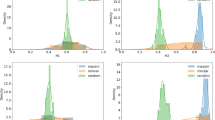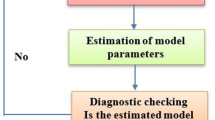Abstract
Tourism demand forecasting has played an important role in supporting governments to devise development policies for travel and tourism. However, time series related to tourism often do not conform to statistical assumptions and feature significant temporal fluctuations. Because a Fourier series is often applied to oscillating sequences to remove noise, it is reasonable to develop a grey prediction model in conjunction with a Fourier series to forecast tourism demand. However, grey prediction models traditionally use one-order accumulation, treating each sample with equal weight, to identify regularities concealed in data sequences. Furthermore, when generating residuals from Fourier series, the prediction accuracy of the newly generated predicted values is not taken into account. In this study, by using fractional order accumulation to assign appropriate weights to samples, we propose a fractional grey prediction model with Fourier series that offers high prediction accuracy. Experimental results demonstrate that the proposed grey prediction model performs well compared with other considered prediction models.



Similar content being viewed by others
References
Askari, M., & Fetanat, A. (2011). Long-term forecasting in power system: Grey system prediction-based models. Journal of Applied Sciences, 11(16), 3034–3038.
Benedetto, F., Mastroeni, L., & Vellucci, P. (2019). Modeling the flow of information between financial time-series by an entropy-based approach. Annals of Operations Research. https://doi.org/10.1007/s10479-019-03319-7.
Chang, C. J., Yu, L., & Jin, P. (2016). A mega-trend-diffusion grey forecasting model for short-term manufacturing demand. Journal of the Operational Research Society, 67(12), 1439–1445.
Chen, C. I. (2008). Application of the novel nonlinear grey Bernoulli model for forecasting unemployment rate. Chaos, Solitons & Fractals, 37(1), 278–287.
Chen, C. I., Chen, H. L., & Chen, S. P. (2008). Forecasting of foreign exchange rates of Taiwan’s major trading partners by novel nonlinear grey Bernoulli model NGBM(1,1). Communications in Nonlinear Science and Numerical Simulations, 13(6), 1194–1204.
Demšar, J. (2006). Statistical comparisons of classifiers over multiple data sets. Journal of Machine Learning Research, 7, 1–30.
Ene, S., & Öztürk, N. (2017). Grey modelling based forecasting system for return flow of end-of-life vehicles. Technological Forecasting and Social Change, 115, 155–166.
Fang, J. (2020). Prediction and analysis of regional economic income multiplication capability based on fractional accumulation and integral model. Chaos, Solitons & Fractals, 130, 109441.
Goldberg, D. E. (1989). Genetic algorithms in search, optimization, and machine learning. Reading: Addison-Wesley.
Habibi, F., Rahim, K. A., Ramchandran, S., & Chin, L. (2009). Dynamic model for international tourism demand for Malaysia: Panel data evidence. International Research Journal of Finance and Economics, 33, 207–217.
Hsu, L. C. (2010). A genetic algorithm based nonlinear grey Bernoulli model for output forecasting in integrated circuit industry. Expert Systems with Applications, 37(6), 4318–4323.
Hu, Y. C. (2017a). Electricity consumption forecasting using a neural-network-based grey prediction approach. Journal of the Operational Research Society, 68(10), 1259–1264.
Hu, Y. C. (2017b). Grey prediction with residual modification using functional-link net and its application to energy demand forecasting. Kybernetes, 46(2), 349–363.
Hu, Y. C., & Jiang, P. (2017). Forecasting energy demand using neural-network-based grey residual modification models. Journal of the Operational Research Society, 68(5), 556–565.
Huang, Y. L., & Lee, Y. H. (2011). Accurately forecasting model for the stochastic volatility data in tourism demand. Modern Economy, 2(5), 823–829.
Iman, R. L., & Davenport, J. M. (1980). Approximations of the critical region of the Friedman statistic. Communications in Statistics, 9(6), 571–595.
Ishibuchi, H., Nakashima, T., & Nii, M. (2004). Classification and modeling with linguistic information granules: Advanced approaches to linguistic data mining. Heidelberg: Springer.
Lee, S. C., & Shih, L. H. (2011). Forecasting of electricity costs based on an enhanced gray-based learning model: A case study of renewable energy in Taiwan. Technological Forecasting and Social Change, 78, 1242–1253.
Li, D. C., Chang, C. J., Chen, C. C., & Chen, W. C. (2012). Forecasting short-term electricity consumption using the adaptive grey-based approach—An Asian case. Omega, 40, 767–773.
Li, C., Qin, J., Li, J., & Hou, Q. (2016). The accident early warning system for iron and steel enterprises based on combination weighting and Grey Prediction Model GM (1,1). Safety Science, 89, 19–27.
Lin, C. J., Chen, H. F., & Lee, T. S. (2011). Forecasting tourism demand using time series, artificial neural networks and multivariate adaptive regression splines: Evidence from Taiwan. International Journal of Business Administration, 2(2), 14–24.
Liu, S., & Lin, Y. (2010). Grey information: Theory and practical applications. Berlin: Springer.
Liu, S., Yang, Y., & Forrest, J. (2017). Grey data analysis: Methods, models and applications. Berlin: Springer.
Lu, J., Xie, W., Zhou, H., & Zhang, A. (2016). An optimized nonlinear grey Bernoulli model and its applications. Neurocomputing, 177, 206–214.
Ma, X., Liu, Z., & Wang, Y. (2019). Application of a novel nonlinear multivariate grey Bernoulli model to predict the tourist income of China. Journal of Computational and Applied Mathematics, 347, 84–94.
Makridakis, S. (1993). Accuracy measures: Theoretical and practical concerns. International Journal of Forecasting, 9(4), 527–529.
Mao, S., Zhu, M., Yan, X., Gao, M., & Xiao, X. (2016). Modeling mechanism of a novel fractional grey model based on matrix analysis. Journal of Systems Engineering and Electronics, 27, 1040–1053.
Murata, T., Ishibuchi, H., & Tanaka, H. (1996). Multi-objective genetic algorithm and its applications to flowshop scheduling. Computers & Industrial Engineering, 30(4), 957–968.
Nguyen, T. L., Huang, J. C., Chiu, C. C., Shu, M. H., & Tsai, W. R. (2013). Forecasting model for the international tourism demand in Taiwan. In Proceedings of 2013 international conference on technology innovation and industrial management, Phuket, Thailand (pp. 61–70 (S5)).
Osyczka, A. (2003). Evolutionary algorithms for single and multicriteria design optimization. New York, NY: Physica-Verlag.
Ouerfelli, C. (2008). Co-integration analysis of quarterly European tourism demand in Tunisia. Tourism Management, 29, 127–137.
Pao, Y. H. (1989). Adaptive pattern recognition and neural networks. Reading: Addison-Wesley.
Pao, Y. H. (1992). Functional-link net computing: Theory, system architecture, and functionalities. Computer, 25(5), 76–79.
Pao, H. T., Fu, H. C., & Tseng, C. L. (2012). Forecasting of CO2 emissions, energy consumption and economic growth in China using an improved grey model. Energy, 40(1), 400–409.
Park, G. H., & Pao, Y. H. (2000). Unconstrained word-based approach for off-line script recognition using density-based random-vector functional-link net. Neurocomputing, 31(1–4), 45–65.
Song, H., Qiu, R. T. R., & Park, J. (2019). A review of research on tourism demand forecasting: Launching the Annals of Tourism Research Curated Collection on tourism demand forecasting. Annals of Tourism Research, 75, 338–362.
Suganthi, L., & Samuel, A. A. (2012). Energy models for demand forecasting—A review. Renewable and Sustainable Energy Reviews, 16, 1223–1240.
Sun, X., Sun, W., Wang, J., & Gao, Y. (2016). Using a Grey–Markov model optimized by Cuckoo search algorithm to forecast the annual foreign tourist arrivals to China. Tourism Management, 52, 369–379.
Tabaszewski, M., & Cempel, C. (2015). Using a set of GM(1,1) models to predict values of diagnostic symptoms. Mechanical Systems and Signal Processing, 52–53, 416–425.
Tsaur, R. C. (2014). Residual analysis using Fourier series transform in Fuzzy time series model. Iranian Journal of Fuzzy Systems, 11(3), 43–54.
Wang, C. H. (2004). Predicting tourism demand using fuzzy time series and hybrid grey theory. Tourism Management, 25(3), 367–374.
Wang, Z. Z., Dang, Y. G., Liu, S. F., & Zhao, J. J. (2009). Solution of GM (1, 1) power model and its properties. Systems Engineering and Electronics, 31(10), 2380–2383.
Wang, J., Du, P., Lu, H., Yang, W., & Niu, T. (2018a). An improved grey model optimized by multi-objective ant lion optimization algorithm for annual electricity consumption forecasting. Applied Soft Computing, 72, 321–337.
Wang, Z. X., & Hao, P. (2016). An improved grey multivariable model for predicting industrial energy consumption in China. Applied Mathematical Modelling, 40(11–12), 5745–5758.
Wang, Z. X., Hipel, K. W., Wang, Q., & He, S. W. (2011). An optimized NGBM(1,1) model for forecasting the qualified discharge rate of industrial wastewater in China. Applied Mathematical Modelling, 35(12), 5524–5532.
Wang, Z. X., Li, Q., & Pei, L. L. (2018b). A seasonal GM(1,1) model for forecasting the electricity consumption of the primary economic sectors. Energy, 1541, 522–534.
Wei, J., Zhou, L., Wang, F., & Wu, D. (2015). Work safety evaluation in Mainland China using grey theory. Applied Mathematical Modelling, 39(2), 924–933.
World Travel and Tourism Council. (2019). The economic impact of travel of travel & tourism. London: World Travel and Tourism Council.
Wu, L., Gao, X., Xiao, Y., Yang, Y., & Chen, X. (2018). Using a novel multi-variable grey model to forecast the electricity consumption of Shandong Province in China. Energy, 157, 327–335.
Wu, L., Liu, S., Fang, Z., & Xu, H. (2015). Properties of the GM(1,1) with fractional order accumulation. Applied Mathematics and Computation, 252, 287–293.
Wu, L., Liu, S., Yao, L., Yan, S., & Liu, D. (2013). The effect of sample size on the grey system model. Applied Mathematical Modelling, 29, 6577–6583.
Wu, D. C., Song, H., & Shen, S. (2017). New developments in tourism and hotel demand modeling and forecasting. International Journal of Contemporary Hospitality Management, 29(1), 507–529.
Xie, M., Wu, L., Li, B., & Li, Z. (2020). A novel hybrid multivariate nonlinear grey model for forecasting the traffic-related emissions. Applied Mathematical Modelling, 77, 1242–1254.
Yang Y, Xue D (2017) Modified grey model predictor design using optimal fractional-order accumulation calculus. IEEE/CAA Journal of Automatica Sinica, 4, 724–733.
Yu, L. A., Wang, Z. S., & Tang, L. (2015a). A decomposition-ensemble model with data-characteristic-driven reconstruction for crude oil price forecasting. Applied Energy, 156, 251–267.
Yu, Y., & Xu, W. (2019). Impact of FDI and R&D on China’s industrial CO2 emissions reduction and trend prediction. Atmospheric Pollution Research, 10, 1627–1635.
Yu, Z., Yang, C., Zhang, Z., & Jiao, J. (2015b). Error correction method based on data transformational GM(1,1) and application on tax forecasting. Applied Soft Computing, 37, 554–560.
Zeng, B., & Meng, W. (2015). Research on Fractional Accumulating Generation Operators and Grey Prediction Models. Scientific Press, Beijing.
Zhou, J., Fang, R., Li, Y., Zhang, Y., & Peng, B. (2009). Parameter optimization of nonlinear grey Bernoulli model using particle swarm optimization. Applied Mathematics and Computation, 207(2), 292–299.
Zhu, J., Wu, P., Chen, H., Liu, J., & Zhou, L. (2019). Carbon price forecasting with variational mode decomposition and optimal combined model. Physica A, 519, 140–158.
Acknowledgements
The author would like to thank the anonymous referees for their valuable comments. This research is supported by the Ministry of Science and Technology, Taiwan, under Grant MOST 108-2410-H-033-038-MY2.
Author information
Authors and Affiliations
Corresponding author
Additional information
Publisher's Note
Springer Nature remains neutral with regard to jurisdictional claims in published maps and institutional affiliations.
Rights and permissions
About this article
Cite this article
Hu, YC. Forecasting tourism demand using fractional grey prediction models with Fourier series. Ann Oper Res 300, 467–491 (2021). https://doi.org/10.1007/s10479-020-03670-0
Published:
Issue Date:
DOI: https://doi.org/10.1007/s10479-020-03670-0




